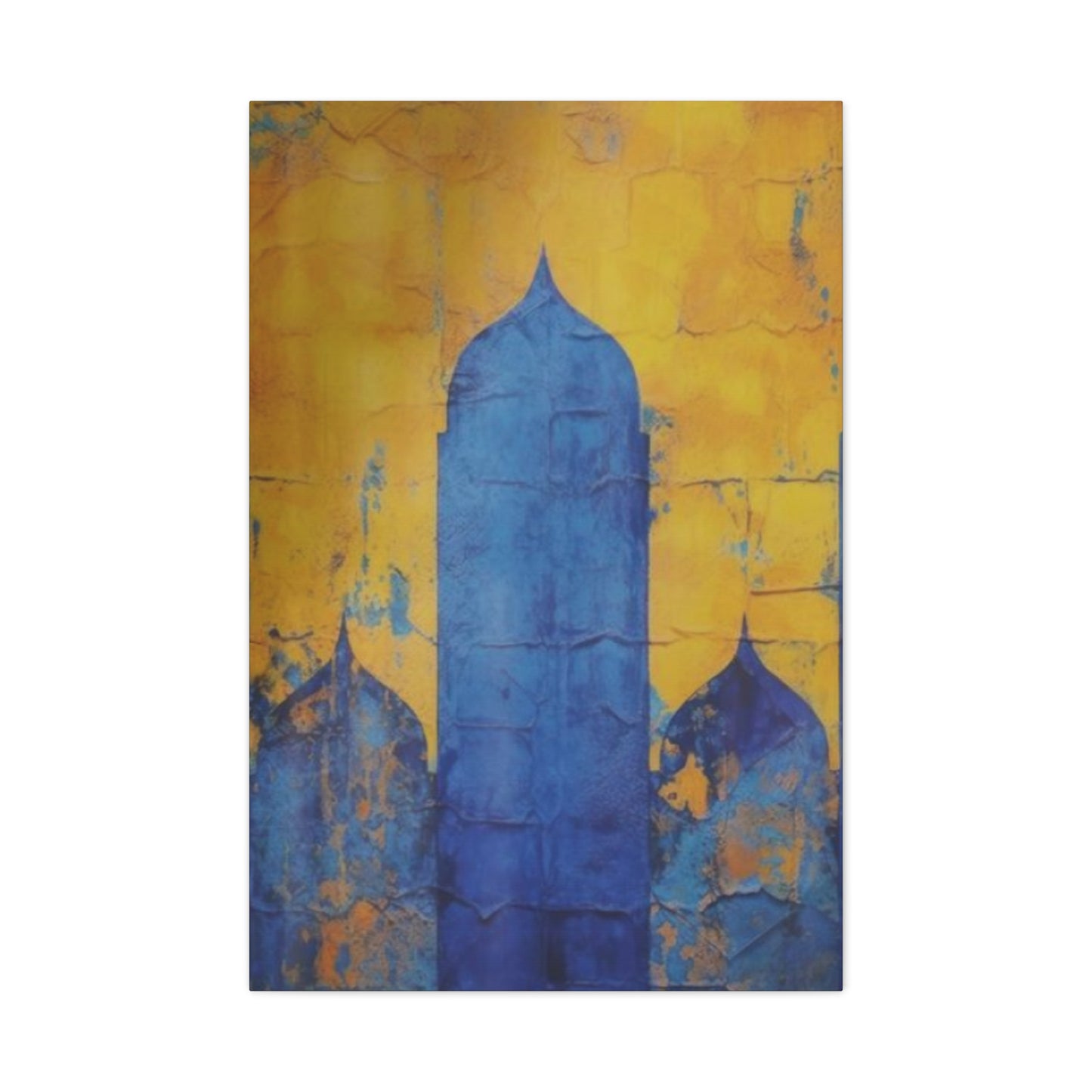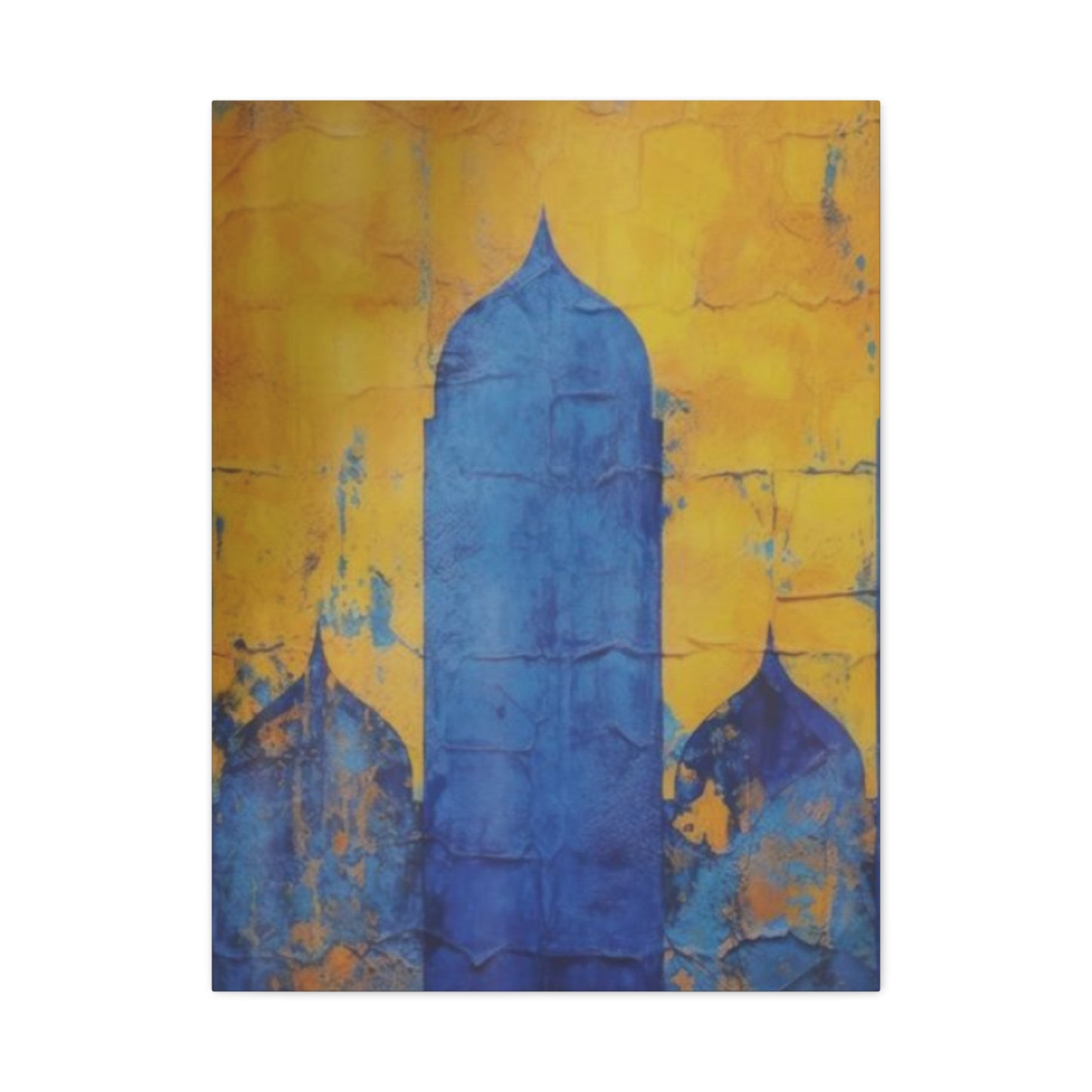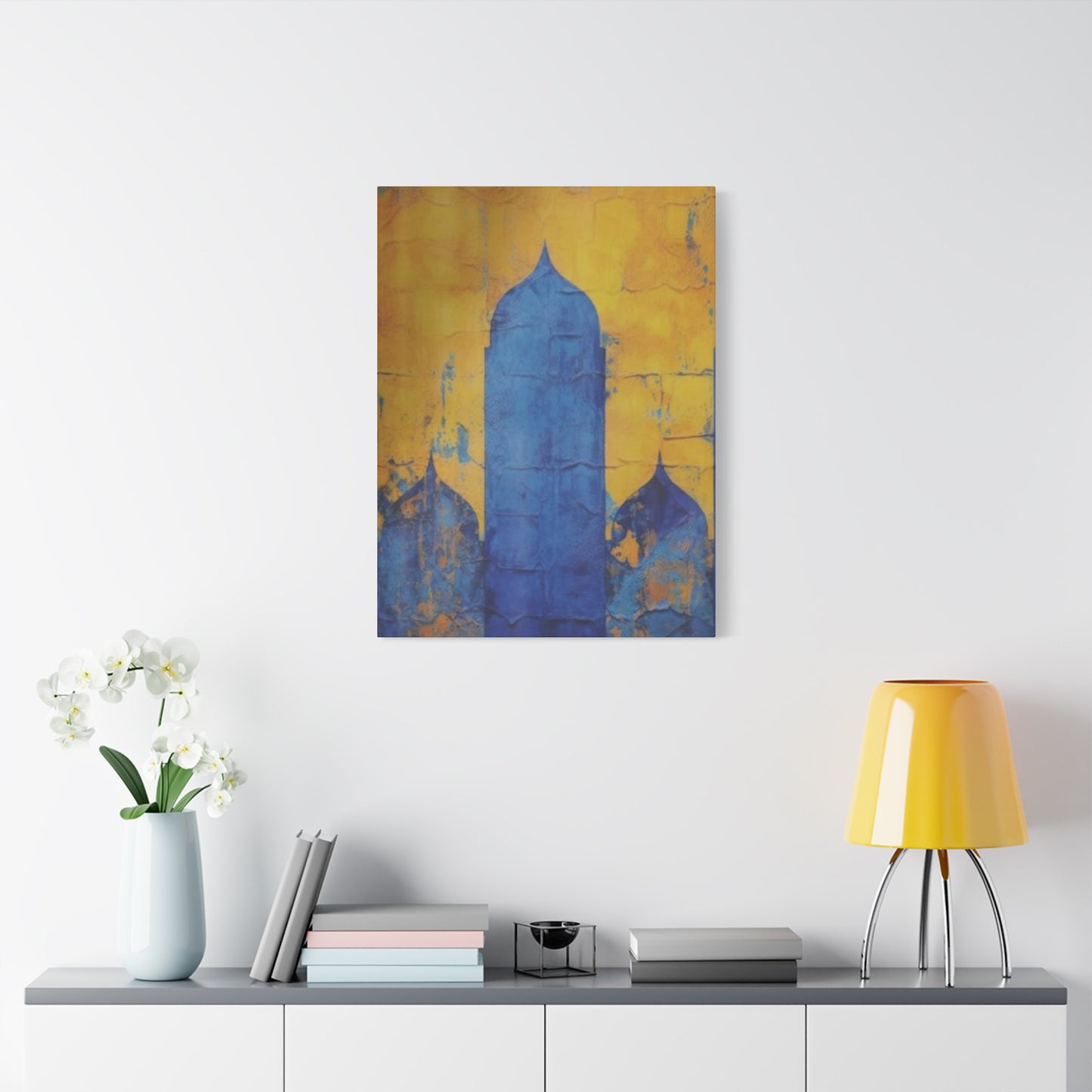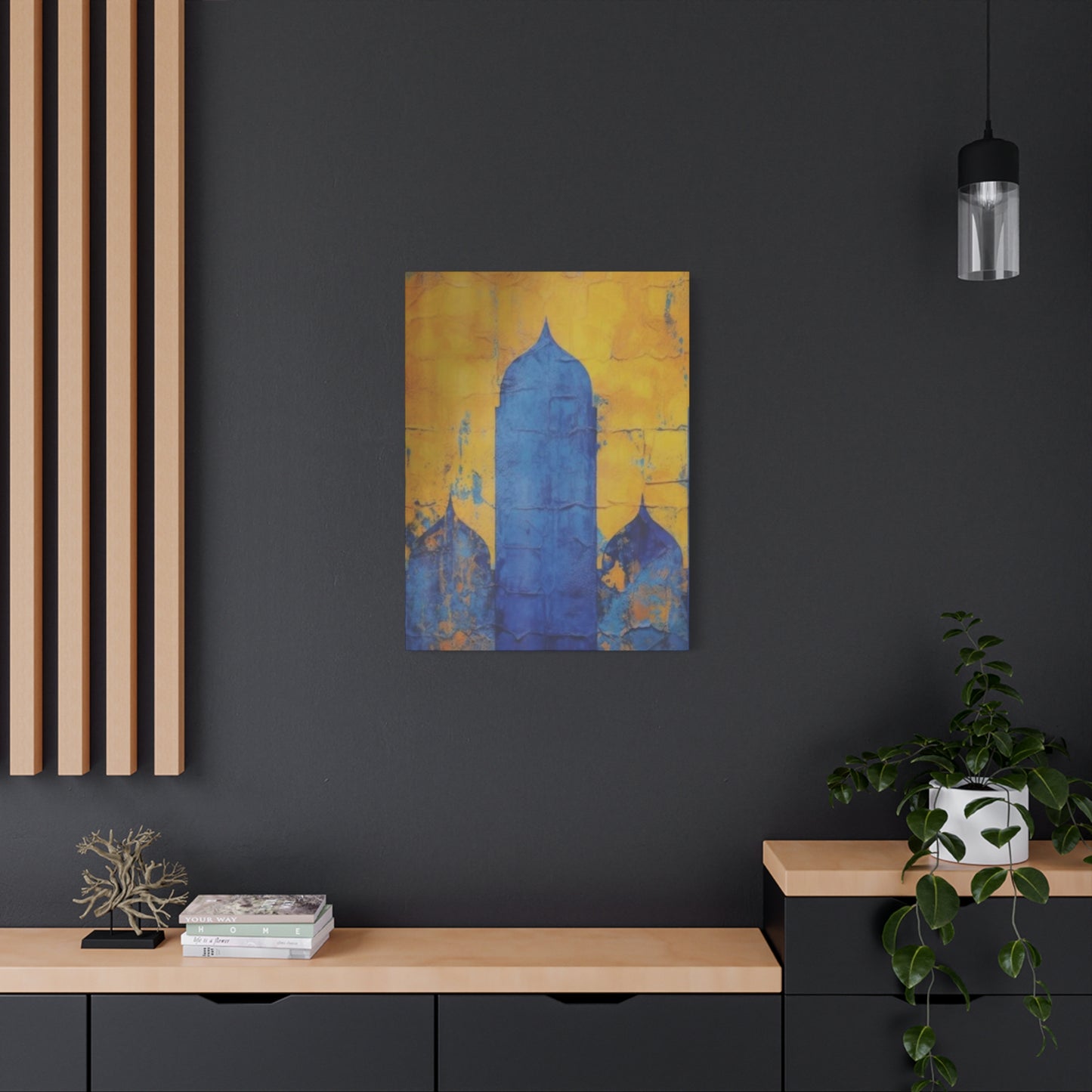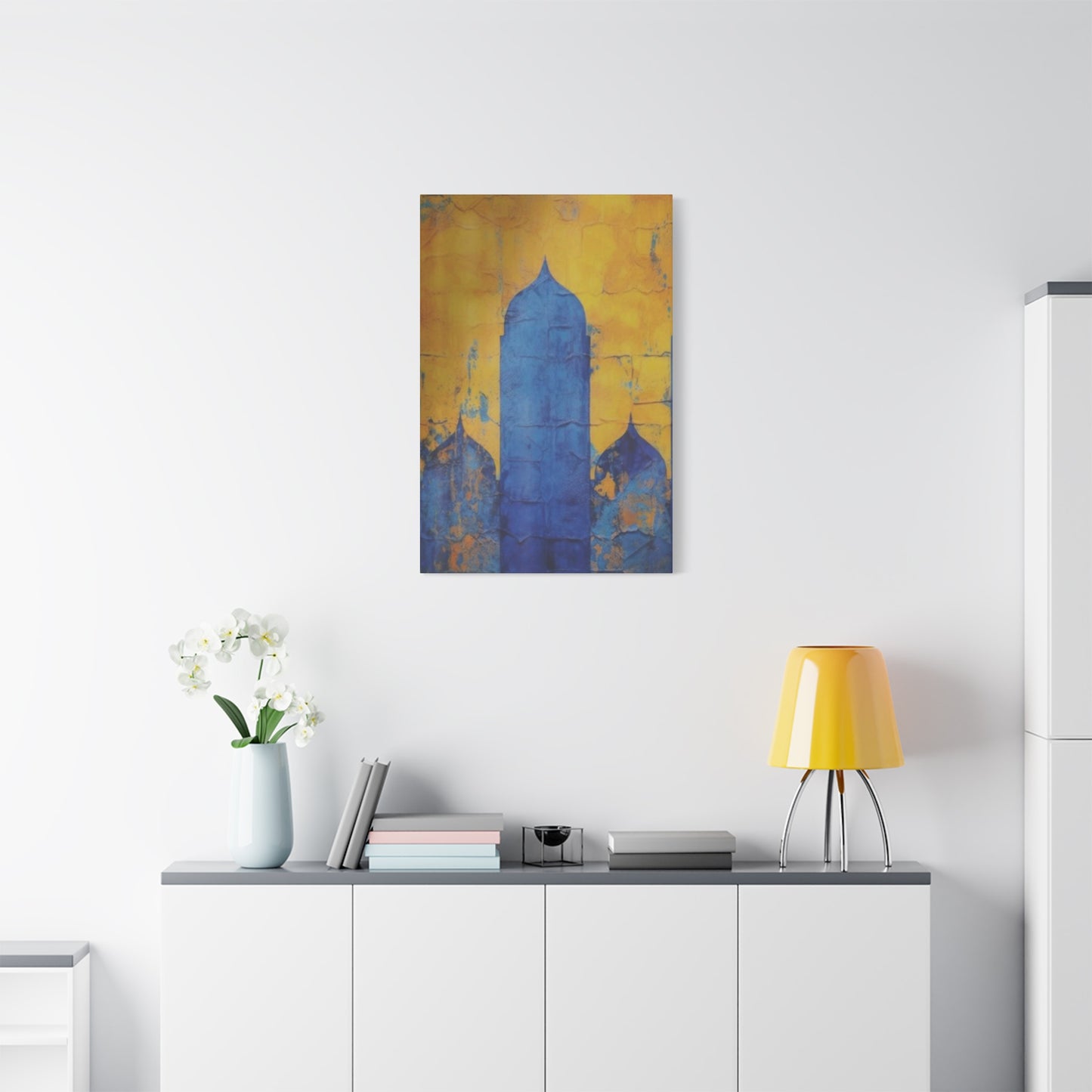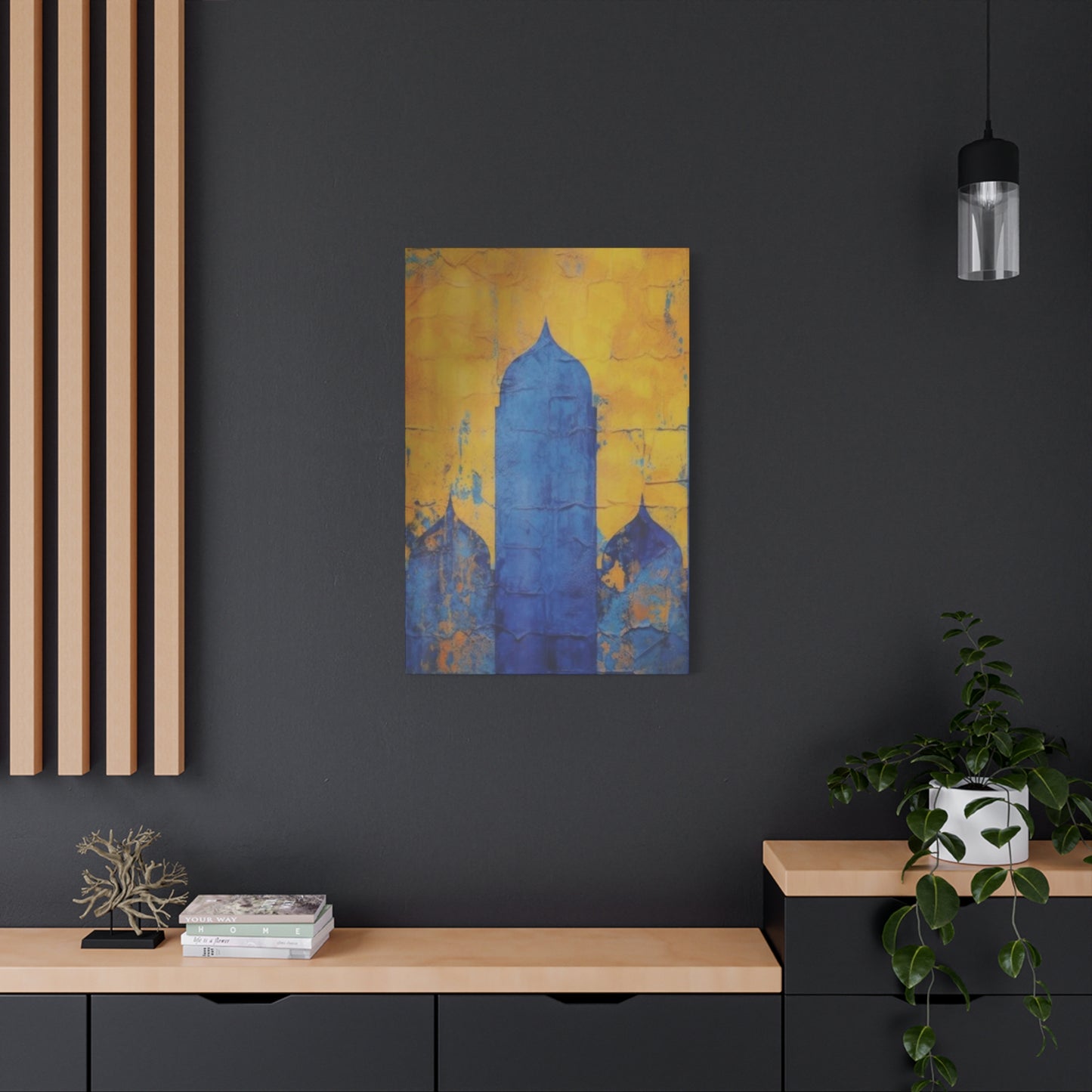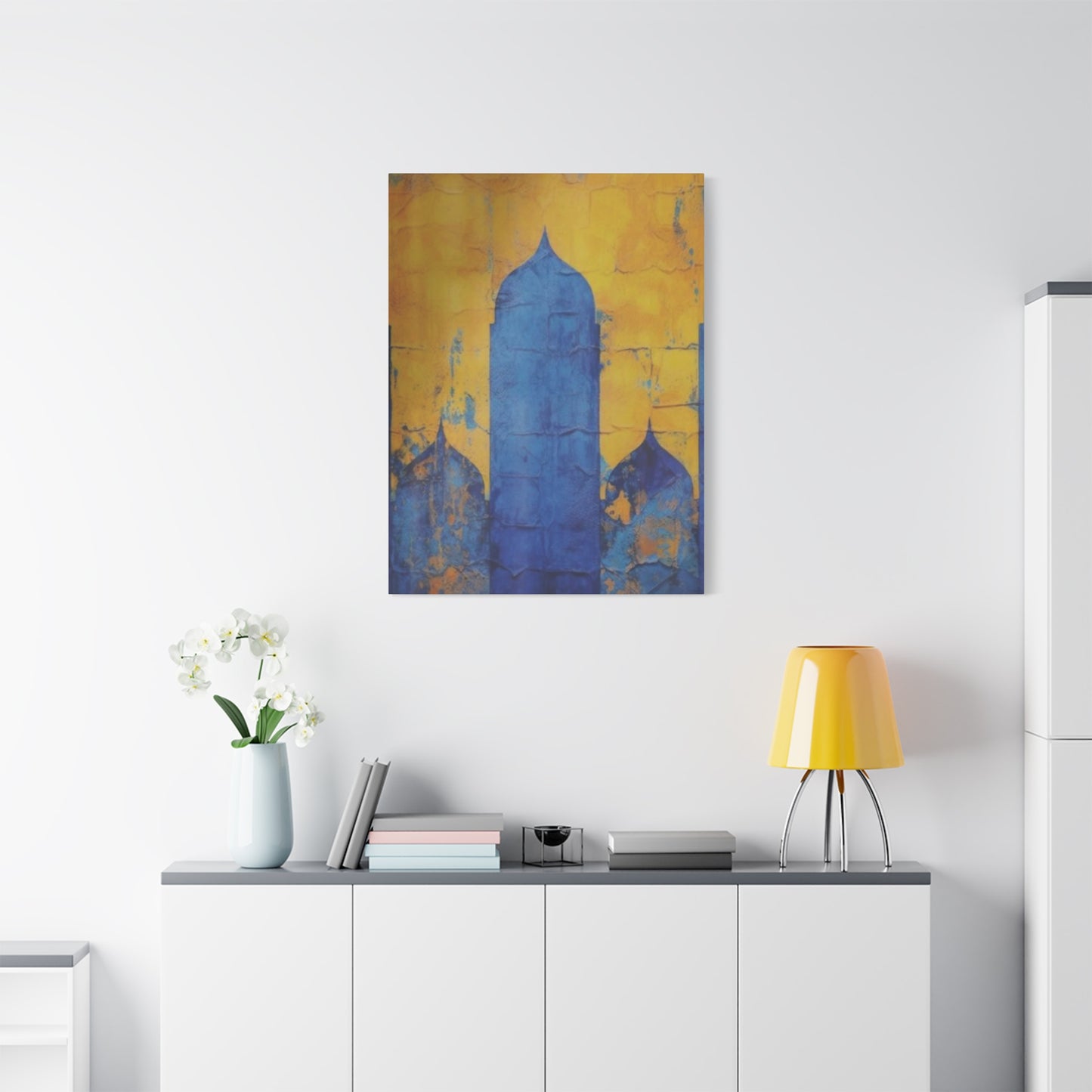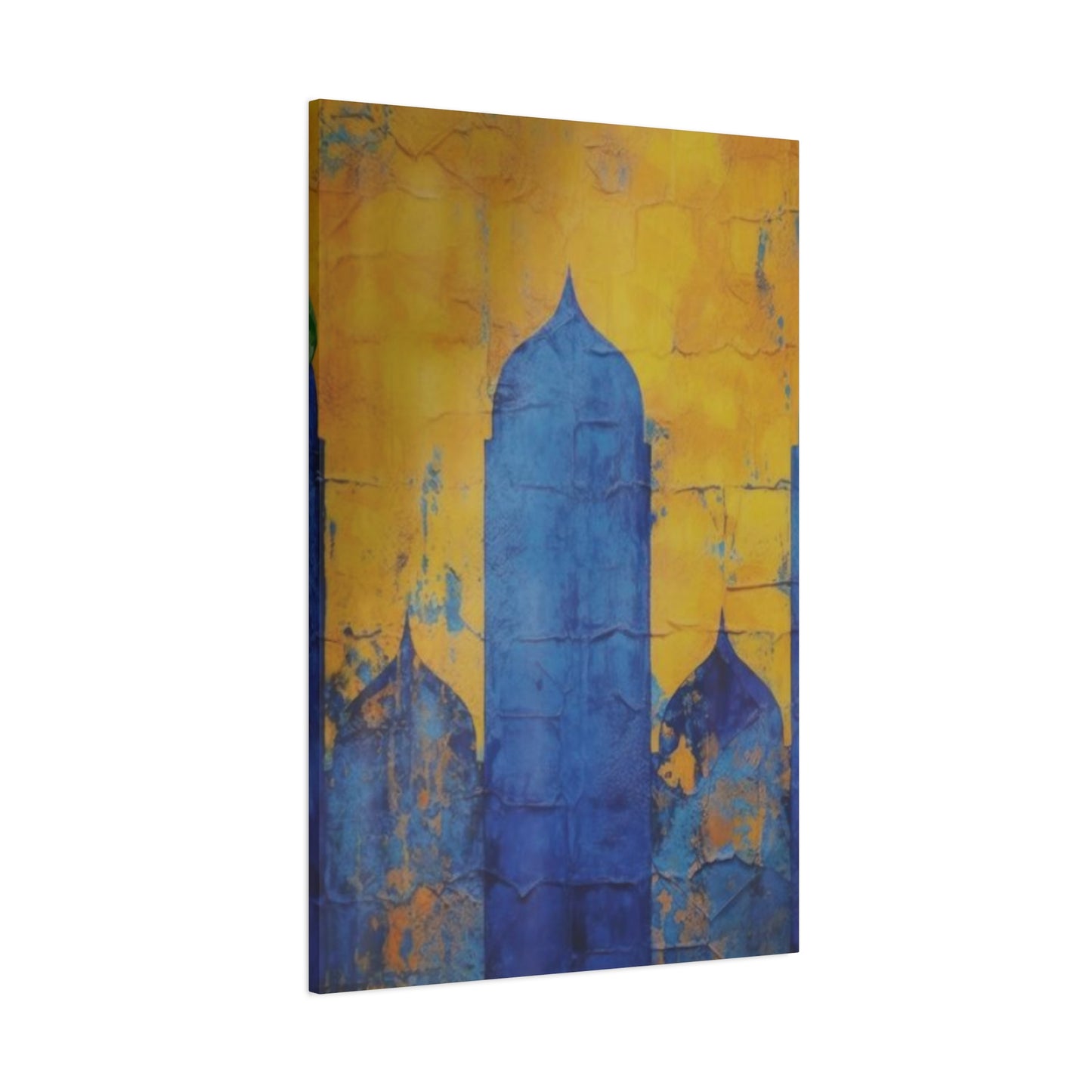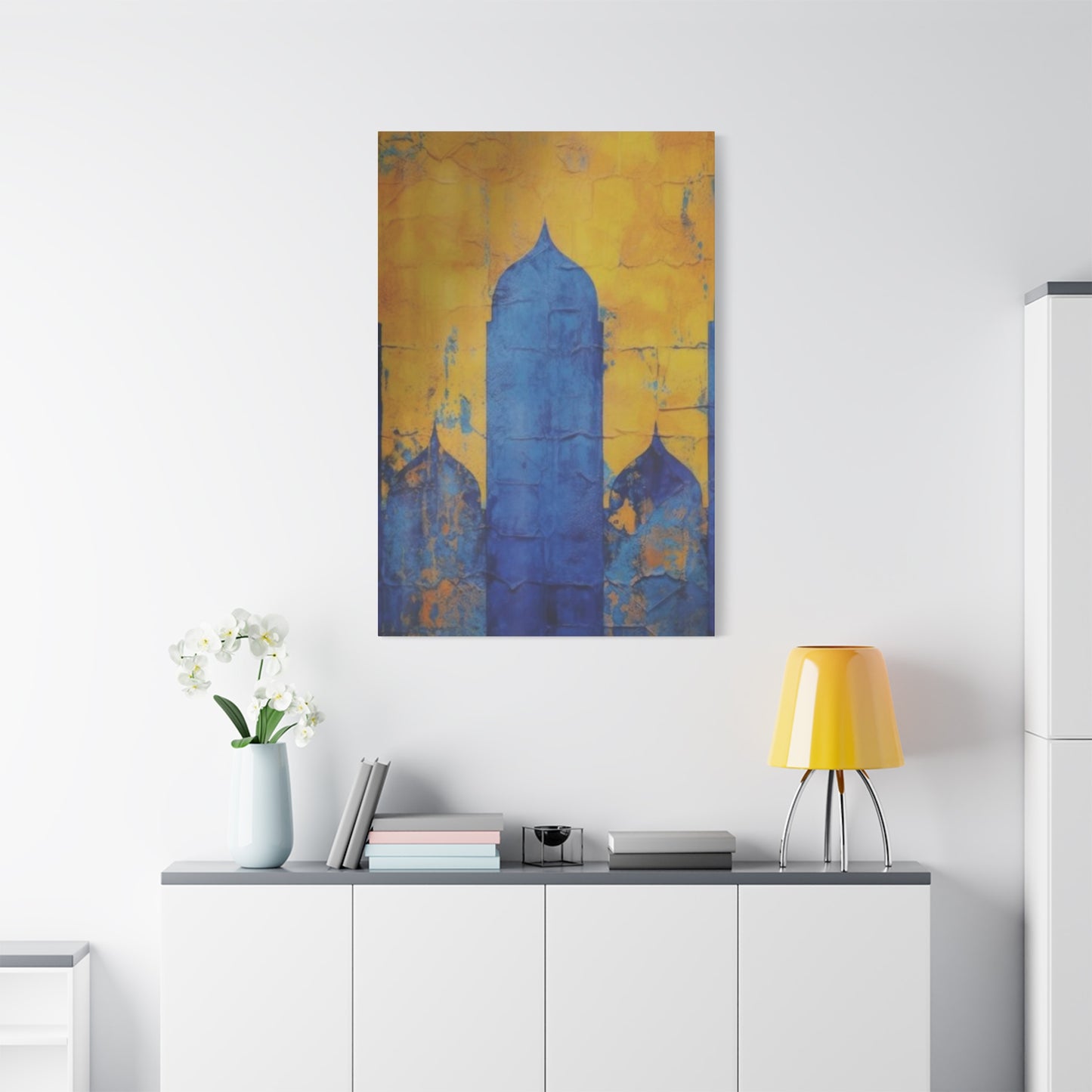Ignite Creativity with Moroccan Canvas Wall Art in Your Office
The mesmerizing world of Moroccan architecture has long captivated art enthusiasts and interior designers alike, particularly when it comes to the stunning combination of blue and yellow hues that define traditional Moroccan buildings. This vibrant color palette, deeply rooted in centuries-old traditions and cultural significance, offers a perfect opportunity to transform modern living spaces through carefully curated wall art and canvas prints. The enchanting blend of azure blues and golden yellows found throughout Morocco's architectural landscape creates an artistic foundation that translates beautifully into contemporary home decor.
From the bustling medinas of Marrakech to the coastal cities of Essaouira, Moroccan architecture showcases a remarkable harmony between color, pattern, and form. The distinctive blue and yellow color scheme that adorns countless buildings throughout the kingdom represents more than mere aesthetic choices; it embodies cultural heritage, spiritual significance, and artistic mastery that has been passed down through generations of skilled craftspeople and architects.
Exploring the Rich Heritage of Blue and Yellow Moroccan Architecture
The foundation of Moroccan architectural beauty lies in its deep historical roots, where blue and yellow pigments have played crucial roles in both practical and symbolic applications. These colors emerged from natural materials readily available in the North African landscape, with blue derived from precious minerals and plants, while yellow came from saffron, turmeric, and other locally sourced materials. The combination of these hues creates a visual symphony that reflects both the earthiness of the desert and the ethereal quality of the Mediterranean sky.
Traditional Moroccan buildings feature these colors in various forms, from intricate tile work known as zellige to painted stucco walls and carved wooden elements. The blue often represents the infinite sky and the protective power of water, while yellow symbolizes the warmth of the sun and the richness of the earth. This symbolic duality creates a balanced aesthetic that resonates with viewers on both conscious and subconscious levels.
The architectural application of blue and yellow extends beyond simple color blocking to encompass complex geometric patterns, arabesques, and calligraphic elements that showcase the sophisticated artistic traditions of Moroccan craftspeople. These patterns often follow mathematical principles that create visual harmony and optical illusions, making each viewing experience unique and engaging.
The preservation of these color traditions in modern Moroccan architecture demonstrates the enduring appeal of this palette. Contemporary architects and designers continue to incorporate blue and yellow elements into new constructions while respecting the historical significance and cultural importance of these chromatic choices.
The Cultural Significance Behind Blue and Yellow Color Palettes
Understanding the cultural context of blue and yellow in Moroccan architecture requires delving into the spiritual and social meanings associated with these colors throughout Islamic and Berber traditions. Blue holds particular significance in Islamic culture, often representing the divine and the infinite nature of Allah's creation. The color is believed to ward off the evil eye and provide protection to inhabitants, making it a popular choice for doorways, windows, and other vulnerable areas of buildings.
Yellow, conversely, represents the earthly realm and human activity. It symbolizes prosperity, knowledge, and the golden light of wisdom that illuminates human understanding. In traditional Moroccan society, the use of yellow pigments often indicated the wealth and status of building owners, as saffron and other yellow dyes were expensive and difficult to obtain.
The combination of blue and yellow creates a visual representation of the connection between heaven and earth, the divine and the mundane. This philosophical approach to color selection reflects the Islamic principle of unity and balance, where opposing forces come together to create harmony and beauty.
Regional variations in the application of these colors also reveal cultural nuances. In coastal areas, blue tones may lean toward turquoise and aqua, reflecting the influence of the Atlantic Ocean and Mediterranean Sea. Inland regions often feature deeper, more intense blues that echo the clarity of desert skies, while yellow tones may range from pale gold to rich amber, depending on local mineral deposits and traditional dye sources.
The social significance of these colors extends to community identity and regional pride. Certain neighborhoods or districts may develop distinctive color signatures that help residents and visitors navigate urban spaces while creating a sense of belonging and cultural continuity.
Traditional Moroccan Architectural Elements in Blue and Yellow
The masterful application of blue and yellow in traditional Moroccan architecture manifests through various architectural elements, each serving both functional and aesthetic purposes. Zellige tilework represents perhaps the most iconic use of these colors, with hand-cut ceramic pieces arranged in complex geometric patterns that cover walls, fountains, and architectural details. The glazed surface of zellige tiles creates depth and luminosity that changes throughout the day as natural light shifts and moves across the surfaces.
Painted stucco work provides another canvas for blue and yellow applications, allowing for larger areas of color application and more fluid, organic patterns. Skilled artisans use traditional lime-based plasters tinted with natural pigments to create smooth, durable surfaces that can withstand the harsh North African climate while maintaining their vibrant appearance for decades.
Wooden elements, including doors, window shutters, and decorative screens, often feature blue and yellow accents through painted designs or inlaid materials. The contrast between the natural wood grain and the vibrant colors creates visual interest while highlighting the craftsmanship involved in creating these functional art pieces.
Metalwork, particularly in wrought iron and brass, frequently incorporates blue and yellow elements through painted finishes or the strategic placement of colored glass and ceramic inserts. These details add sparkle and movement to architectural features while maintaining the overall color harmony of the building.
Textile elements, including awnings, curtains, and decorative hangings, provide opportunities for incorporating blue and yellow patterns in more temporary and changeable ways. These soft furnishings allow residents to adjust the intensity of color in their spaces while protecting interiors from harsh sunlight and maintaining privacy.
Canvas Art Inspired by Moroccan Blue and Yellow Architecture
The translation of architectural elements into canvas art requires careful consideration of composition, scale, and artistic technique to capture the essence of Moroccan design while creating pieces suitable for contemporary interiors. Artists working in this genre often focus on specific architectural details, such as doorways, window frames, or tile patterns, that can be isolated and celebrated as standalone compositions.
Photographic approaches to Moroccan architectural canvas art emphasize the interplay of light and shadow across blue and yellow surfaces, capturing the dynamic quality of these colors throughout different times of day. High-quality printing techniques ensure that the vibrancy and depth of the original colors are maintained, allowing viewers to experience something approaching the visual impact of being present in these architectural spaces.
Abstract interpretations of Moroccan architectural elements offer artists the freedom to explore color relationships and pattern variations while maintaining the essential spirit of the source material. These pieces often emphasize the emotional and psychological impact of blue and yellow combinations, creating artworks that evoke the feeling of Moroccan spaces without literal representation.
Mixed media approaches combine photographic elements with painted or digital enhancements, creating layered compositions that blur the line between documentation and artistic interpretation. These techniques allow for the enhancement of certain color aspects while maintaining the authenticity of architectural details.
The scale of canvas art pieces significantly impacts their effectiveness in interior spaces. Large-format pieces can serve as focal points that transform entire rooms, while smaller works can be grouped to create gallery walls that tell more complex visual stories about Moroccan architectural traditions.
Wall Decor Options Featuring Moroccan Architectural Themes
Contemporary wall decor inspired by Moroccan blue and yellow architecture offers numerous options for integrating these striking visual elements into modern living spaces. Framed prints provide the most accessible entry point, allowing homeowners to experiment with Moroccan-inspired design without major financial investment or permanent installation commitment.
Metal wall art interpreting Moroccan architectural motifs brings dimensional interest to flat wall surfaces while echoing the metalwork traditions found in traditional Moroccan buildings. These pieces often feature laser-cut patterns that create shadow play reminiscent of the light filtering through traditional Moroccan screens and architectural details.
Removable wall decals and wallpaper featuring Moroccan architectural patterns offer temporary decoration solutions perfect for rental properties or those who prefer to change their decor frequently. Modern printing technology allows for high-resolution reproduction of architectural details and color accuracy that closely matches original sources.
Three-dimensional wall installations that incorporate actual materials used in Moroccan architecture, such as ceramic tiles or carved wood elements, create immersive experiences that engage multiple senses. These installations require more planning and investment but provide unparalleled authenticity and visual impact.
Lighting solutions that complement Moroccan architectural wall decor include fixtures that cast patterned shadows or colored light that enhances blue and yellow wall elements. These lighting choices help create atmospheric conditions similar to those found in traditional Moroccan interiors.
Modern Interior Design Applications for Blue and Yellow Moroccan Art
Integrating blue and yellow Moroccan architectural art into contemporary interior design requires thoughtful consideration of existing color schemes, architectural features, and lifestyle needs. The key lies in balancing the vibrant, pattern-rich nature of Moroccan design with the clean lines and simplified aesthetics often preferred in modern homes.
Living room applications might feature large-scale canvas pieces as focal points above sofas or mantels, complemented by smaller accent pieces that reinforce the color theme without overwhelming the space. The blue and yellow palette works particularly well with neutral backgrounds, allowing the Moroccan elements to stand out while maintaining overall visual harmony.
Bedroom installations of Moroccan architectural art can create calming, exotic atmospheres that promote relaxation and peaceful sleep. The key is selecting pieces with appropriate color intensity and subject matter that supports the room's primary function while adding visual interest and cultural depth.
Kitchen and dining areas provide opportunities for incorporating smaller Moroccan architectural pieces that complement the functional nature of these spaces. Blue and yellow elements can tie together disparate materials and finishes while adding warmth and personality to utilitarian environments.
Home office spaces benefit from Moroccan architectural art that provides visual stimulation without being overly distracting. The geometric patterns and balanced color relationships found in traditional Moroccan design can actually enhance focus and creativity while making work environments more pleasant and inspiring.
Bathroom applications require careful consideration of humidity and ventilation, but properly protected Moroccan architectural art can transform these functional spaces into exotic retreats that provide daily doses of beauty and cultural enrichment.
Color Psychology and the Impact of Blue and Yellow Combinations
The psychological effects of blue and yellow color combinations play a significant role in their enduring popularity and effectiveness in interior design applications. Blue is universally associated with calmness, trust, and stability, making it an ideal choice for creating serene environments that promote relaxation and mental clarity. The color has been shown to lower blood pressure and heart rate, creating physiological responses that support stress reduction and overall well-being.
Yellow brings energy, optimism, and creativity to any space, stimulating mental activity and encouraging positive emotional responses. The color is associated with intellectual pursuits, communication, and social interaction, making it valuable for spaces where these activities are important. However, yellow must be used judiciously, as excessive amounts can create anxiety or restlessness in some individuals.
The combination of blue and yellow creates a dynamic tension that keeps spaces interesting while maintaining overall balance. This complementary relationship on the color wheel ensures that neither color overwhelms the other, instead creating visual harmony that feels both exciting and comfortable.
Cultural conditioning also influences responses to blue and yellow combinations, with many people associating these colors with positive experiences such as sunny skies over blue water, spring flowers, or beloved cultural traditions. These associations enhance the emotional impact of Moroccan architectural art featuring these colors.
The intensity and saturation levels of blue and yellow significantly impact their psychological effects. Deep, rich blues create feelings of luxury and sophistication, while lighter blues feel more casual and approachable. Similarly, golden yellows evoke wealth and warmth, while pale yellows feel fresh and clean.
Photographic Techniques for Capturing Moroccan Architecture
Professional photography of Moroccan architectural subjects requires specialized knowledge of lighting conditions, composition principles, and cultural sensitivities to create images suitable for high-quality canvas art reproduction. The intense North African sun creates challenging lighting conditions that can wash out colors or create harsh shadows that obscure architectural details.
Golden hour photography, typically occurring in the hour after sunrise and before sunset, provides optimal conditions for capturing the warmth and richness of blue and yellow architectural elements. During these times, the natural light enhances color saturation while creating dramatic shadows that emphasize texture and dimensional qualities.
Polarizing filters help manage reflections from glazed surfaces and enhance color contrast, particularly important when photographing zellige tiles or other glossy architectural elements. These filters also help reduce glare that can make blue and yellow surfaces appear washed out or inaccurate.
Composition techniques that emphasize the geometric nature of Moroccan architectural design include careful attention to symmetry, pattern repetition, and the relationship between positive and negative space. Framing techniques that isolate specific architectural elements allow viewers to appreciate the intricacy of craftsmanship without visual distractions.
Post-processing considerations for architectural photography intended for canvas reproduction include color accuracy, detail enhancement, and print preparation. Digital techniques can enhance the vibrancy of blue and yellow elements while maintaining natural appearance and avoiding over-saturation that appears artificial.
Digital Art Creation Inspired by Moroccan Architecture
Digital art creation offers contemporary artists unlimited possibilities for exploring and reinterpreting traditional Moroccan architectural themes while maintaining the essential character of blue and yellow color schemes. Vector-based illustration programs allow for precise recreation of geometric patterns and architectural details that can be scaled to any size without quality loss.
Digital painting techniques can simulate traditional media while offering advantages such as unlimited undo capabilities, layer-based composition, and non-destructive editing. These tools enable artists to experiment with color variations and composition alternatives that would be time-consuming or impossible with traditional media.
3D modeling and rendering software can recreate Moroccan architectural spaces with photorealistic accuracy, allowing for virtual exploration of color and lighting possibilities. These techniques are particularly valuable for creating idealized representations of architectural elements that emphasize blue and yellow relationships.
Digital collage techniques combine photographic elements with painted or drawn components, creating hybrid artworks that blend documentation with artistic interpretation. These approaches allow for creative freedom while maintaining connection to authentic architectural sources.
Print preparation for digital art requires careful attention to color management, resolution requirements, and substrate characteristics. The translation from digital display to physical canvas involves color space conversions and technical considerations that impact final appearance and longevity.
Printing Technologies for High-Quality Architectural Art
Modern printing technologies have revolutionized the reproduction of architectural photography and artwork, enabling the creation of canvas prints that rival traditional painting techniques in terms of color accuracy, detail resolution, and longevity. Giclée printing represents the current standard for fine art reproduction, utilizing archival inks and substrates to ensure decades of fade-resistant display.
Canvas substrates vary significantly in texture, weight, and preparation, each affecting the final appearance of printed architectural images. Heavy cotton canvases provide durability and professional appearance, while synthetic materials offer specific advantages for high-detail reproduction and color accuracy.
Ink technologies including pigment-based and dye-based formulations each offer distinct advantages for architectural art reproduction. Pigment inks provide superior longevity and color stability, while dye inks can achieve higher color saturation and smoother gradients in certain applications.
Color management throughout the printing process ensures that the blue and yellow tones in Moroccan architectural art match artist and client expectations. Professional color calibration involves monitor calibration, printer profiling, and proofing procedures that maintain consistency from digital file to final print.
Finishing options including protective coatings, stretching techniques, and framing choices significantly impact the presentation and longevity of architectural canvas art. These decisions should consider both aesthetic preferences and practical considerations such as intended display location and maintenance requirements.
Geometric Patterns in Moroccan Architectural Art
The geometric patterns that characterize Moroccan architectural decoration represent a sophisticated mathematical and artistic tradition that translates beautifully into contemporary wall art applications. These patterns, rooted in Islamic artistic principles, create visual rhythms and optical effects that engage viewers while demonstrating the geometric principles underlying natural phenomena.
Star and polygon patterns form the foundation of many Moroccan architectural decorations, with eight-pointed stars and various polygonal shapes creating complex tessellations that can extend infinitely in all directions. The blue and yellow color applications within these patterns create additional layers of visual interest and meaning.
Interlacing patterns that weave over and under themselves create illusions of depth and movement that animate flat surfaces. When rendered in blue and yellow color schemes, these patterns can create optical effects that change depending on viewing distance and lighting conditions.
Border and frame patterns provide structure and containment for larger decorative schemes while serving as transitional elements between different architectural surfaces. These patterns often incorporate blue and yellow elements in rhythmic alternations that create visual unity across diverse architectural features.
The mathematical precision required for traditional geometric pattern creation has been enhanced by digital tools that allow for perfect accuracy and infinite variation. Contemporary artists can explore traditional patterns while developing new interpretations that maintain the essential character of Moroccan architectural decoration.
Tile Work and Mosaic Inspirations for Wall Art
Moroccan zellige tile work represents one of the world's most sophisticated ceramic traditions, with techniques and patterns that have remained essentially unchanged for over a thousand years. The reproduction of these intricate mosaic patterns in canvas art form allows for the appreciation of this craftsmanship in contexts where actual tile installation is impractical or impossible.
The hand-cut nature of traditional zellige creates subtle variations in size and shape that contribute to the overall beauty and authenticity of finished installations. Canvas reproductions can capture these imperfections and variations, maintaining the human quality that distinguishes traditional craftsmanship from machine production.
Color variations within individual tiles create depth and richness that change as lighting conditions shift throughout the day. High-quality canvas reproductions can simulate these subtle color shifts through careful attention to printing techniques and substrate selection.
Pattern combinations in traditional zellige work follow established conventions that have been refined over centuries of practice. Understanding these pattern relationships helps contemporary artists create authentic-feeling reproductions while allowing for creative interpretation and adaptation.
The scale relationships between individual tile elements and overall pattern compositions provide guidance for canvas art sizing and composition decisions. Successful translations maintain these proportional relationships while adapting to the different viewing distances and contexts typical of interior wall art.
Architectural Photography as Fine Art
The elevation of architectural photography to fine art status requires moving beyond mere documentation to create images that communicate emotional and aesthetic responses to built environments. Moroccan architecture, with its rich blue and yellow color palettes and intricate details, provides exceptional subject matter for this artistic approach.
Compositional strategies that emphasize the artistic qualities of architectural subjects include careful attention to framing, perspective, and the relationship between architectural elements and natural lighting. The goal is creating images that work as standalone artworks while accurately representing their architectural sources.
The decisive moment in architectural photography often involves waiting for optimal lighting conditions that reveal the full beauty of blue and yellow architectural elements. This patience is rewarded with images that capture not just appearance but also the emotional impact of these spaces.
Series development allows photographers to explore architectural themes in depth, creating bodies of work that can be displayed together to tell more complex visual stories. Moroccan architectural series might explore regional variations, historical periods, or specific building types.
The transition from photography to wall art involves selection processes that identify images with the strongest artistic merit and broadest appeal. Not all successful architectural photographs translate effectively to canvas art applications, requiring careful curation and presentation decisions.
Canvas Sizing and Placement Considerations
The selection of appropriate canvas sizes for Moroccan architectural art requires careful consideration of wall dimensions, viewing distances, and the scale of architectural elements depicted in the artwork. Large-format pieces that showcase intricate architectural details need sufficient size to allow viewers to appreciate the complexity and craftsmanship represented.
Viewing distance calculations help determine optimal sizing for specific installation locations. Artwork intended for close viewing can include more detail and complexity, while pieces meant to be seen from greater distances should emphasize bold shapes and strong color contrasts.
Proportional relationships between canvas dimensions and architectural subjects help maintain visual authenticity and prevent distortion of architectural elements. Traditional Moroccan architectural proportions follow established mathematical relationships that should be respected in art reproductions.
Wall space assessment includes consideration of existing architectural features, furniture placement, and traffic patterns that might affect artwork placement and viewing. The goal is finding locations where Moroccan architectural art can be properly appreciated without competing with other design elements.
Multiple piece installations require careful planning to ensure proper spacing, alignment, and visual relationships between individual canvases. Gallery wall arrangements can tell complex visual stories while maintaining overall design coherence.
Framing and Presentation Options
Professional framing and presentation significantly impact the effectiveness of Moroccan architectural canvas art in interior design applications. The choice between traditional frames, contemporary alternatives, and frameless presentations should complement both the artwork and the surrounding decor.
Traditional framing with ornate, decorative frames can enhance the exotic and historical character of Moroccan architectural art while providing clear boundaries between artwork and surrounding wall surfaces. However, these approaches risk creating visual competition between frame and image.
Contemporary framing with clean, minimal frames allows the artwork to dominate while providing necessary protection and visual separation from wall surfaces. This approach works particularly well in modern interiors where traditional ornate frames might appear incongruous.
Frameless presentations including gallery wraps and museum mounting create seamless integration between artwork and wall surfaces while emphasizing the contemporary aspects of Moroccan architectural art reproduction. These approaches require careful attention to edge finishing and mounting hardware.
Matting considerations for framed presentations can enhance color relationships and provide visual breathing room around architectural images. Mat colors should complement rather than compete with the blue and yellow elements in the artwork.
Glazing options including standard glass, museum glass, and acrylic alternatives each offer different advantages for protecting and presenting architectural art. The choice depends on lighting conditions, security concerns, and budget considerations.
Lighting Design for Moroccan Architectural Art
Proper lighting design enhances the visual impact of Moroccan architectural canvas art while protecting valuable pieces from damage caused by excessive ultraviolet exposure or heat buildup. The goal is creating lighting conditions that reveal the full beauty of blue and yellow color relationships while maintaining artwork longevity.
Track lighting systems offer flexibility for adjusting illumination angles and intensity to accommodate different pieces and changing display arrangements. This adaptability is particularly valuable for collections that include multiple Moroccan architectural artworks with varying lighting requirements.
Picture lighting with dedicated fixtures for individual artworks provides focused illumination that enhances specific pieces without affecting surrounding areas. These fixtures can be integrated into traditional or contemporary decor schemes while providing optimal viewing conditions.
Natural lighting considerations include the direction and intensity of available daylight and how it interacts with blue and yellow elements in Moroccan architectural art. South-facing windows provide strong, warm light that can enhance yellow tones, while north-facing exposures offer more consistent, cool illumination.
LED technology offers advantages including energy efficiency, longevity, and precise color temperature control that can be adjusted to complement specific artworks. The reduced heat output of LED fixtures also minimizes potential damage to canvas and ink materials.
UV filtering in both natural and artificial lighting situations helps preserve the vibrancy of blue and yellow pigments over time. Window films, UV-filtering glazing, and specialized light fixtures all contribute to artwork preservation while maintaining viewing quality.
Color Matching and Interior Design Integration
Successful integration of blue and yellow Moroccan architectural art into existing interior design schemes requires careful attention to color relationships, pattern scales, and stylistic compatibility. The intense colors and intricate patterns typical of Moroccan design can overwhelm spaces that are not properly prepared to accommodate them.
Neutral background strategies provide safe foundations for introducing vibrant Moroccan architectural art without creating visual chaos. White, beige, and gray wall colors allow blue and yellow elements to stand out while maintaining overall balance and sophistication.
Complementary color schemes that build on the blue and yellow foundation can create rich, layered interiors that feel both exotic and comfortable. Orange and violet accents, being complementary to blue and yellow respectively, can enhance the impact of Moroccan architectural art while maintaining color harmony.
Pattern mixing requires careful attention to scale relationships and visual weight distribution. Large-scale Moroccan architectural patterns work best when balanced with smaller-scale patterns or solid colors that provide visual rest areas.
Textile coordination including rugs, pillows, and window treatments can reinforce the blue and yellow color theme while adding texture and comfort to spaces featuring Moroccan architectural art. The key is maintaining balance between pattern and solid elements.
Furniture selection should complement rather than compete with Moroccan architectural art installations. Clean-lined contemporary pieces often work better than ornate traditional furniture that might create visual competition with intricate architectural patterns.
Regional Variations in Moroccan Blue and Yellow Architecture
Different regions of Morocco have developed distinctive approaches to using blue and yellow in architectural applications, reflecting local materials, climate conditions, and cultural influences. Understanding these regional characteristics helps inform artistic choices and provides context for canvas art selections.
Coastal regions including Essaouira and Rabat often feature blues that tend toward turquoise and aqua, reflecting the influence of nearby ocean waters. These cooler blue tones create different moods and work better with certain interior design schemes than the deeper blues found in inland areas.
Mountain regions such as the Atlas Mountains area typically use deeper, more intense blues that echo the clarity of high-altitude skies, while yellow tones may incorporate earth pigments that reflect local geological conditions. These color variations create artwork with different emotional impacts and design compatibility.
Desert edge communities often feature yellow tones that range toward amber and gold, reflecting the warm light conditions and earth materials characteristic of these environments. The blues used in these areas may be more muted to create harmony with the intense yellow elements.
Urban versus rural applications of blue and yellow show interesting distinctions, with city buildings often featuring more standardized color applications while rural structures may show more individual variation and creative interpretation of traditional themes.
Historical periods have also influenced regional color applications, with certain eras favoring specific blue and yellow combinations that reflect available materials, trade relationships, and cultural exchanges with other regions.
Preservation and Conservation of Architectural Colors
The preservation of traditional blue and yellow color applications in Moroccan architecture presents ongoing challenges due to environmental factors, modern materials, and changing maintenance practices. Understanding these preservation issues provides context for the importance of documenting architectural colors through photography and art reproduction.
Natural aging processes affect blue and yellow pigments differently, with some blues fading more rapidly than yellows under intense sunlight exposure. These aging patterns create patina effects that many find aesthetically pleasing but represent loss of original artistic intent.
Environmental factors including air pollution, acid rain, and temperature fluctuations accelerate color degradation and require active conservation efforts to maintain architectural color integrity. These challenges highlight the value of high-quality art reproductions as preservation tools.
Modern restoration techniques attempt to match original colors using contemporary materials that may offer better longevity than historical pigments. However, these interventions raise questions about authenticity and the appropriate balance between preservation and historical accuracy.
Documentation projects that photograph and catalog traditional color applications provide valuable resources for future restoration efforts while creating archives that can inspire contemporary art creation. These projects often reveal color combinations and techniques that might otherwise be lost.
The role of art reproduction in preservation extends beyond simple documentation to include the creation of educational and cultural materials that raise awareness of architectural heritage and support conservation efforts through increased public appreciation.
Contemporary Artists Working with Moroccan Themes
A growing number of contemporary artists are exploring Moroccan architectural themes, bringing fresh perspectives to traditional blue and yellow color applications while maintaining respect for cultural authenticity and artistic heritage. These artists work in various media and styles, from photorealistic representation to abstract interpretation.
Photography specialists focusing on Moroccan architecture often spend years developing relationships with local communities and understanding cultural contexts that inform their artistic approach. Their work goes beyond tourist imagery to reveal deeper cultural meanings and artistic sophistication.
Digital artists are exploring new possibilities for interpreting traditional Moroccan patterns and colors, using technology to create variations and combinations that would be impossible with traditional media. These explorations push boundaries while maintaining connection to historical sources.
Mixed media artists combine traditional materials with contemporary techniques, creating works that bridge historical and modern approaches to Moroccan architectural themes. These pieces often incorporate actual materials from Morocco alongside photographic and painted elements.
Abstract artists use Moroccan architectural elements as inspiration rather than literal subject matter, exploring the emotional and psychological impacts of blue and yellow color relationships while creating entirely contemporary artworks.
International artists bring outside perspectives to Moroccan themes, creating cross-cultural dialogues that reveal universal aspects of architectural beauty while respecting specific cultural contexts and meanings.
Market Trends in Architectural Wall Art
The market for architectural wall art, particularly pieces inspired by Moroccan design themes, has shown steady growth as consumers seek unique, culturally rich alternatives to mass-produced decorative art. This trend reflects broader interests in global culture, artisanal craftsmanship, and authentic design experiences.
Size preferences in architectural wall art have shifted toward larger formats that create significant visual impact in contemporary interiors. Consumers are willing to invest in statement pieces that serve as focal points rather than purchasing multiple smaller works.
Quality expectations have increased significantly, with buyers demanding museum-quality reproduction techniques, archival materials, and professional presentation. This trend has pushed the industry toward higher standards while eliminating lower-quality options.
Customization services are becoming increasingly important, with consumers seeking artwork tailored to specific color schemes, sizing requirements, and stylistic preferences. This trend creates opportunities for artists and publishers to offer personalized solutions.
Online purchasing has become dominant in the architectural wall art market, requiring high-quality digital photography and detailed product descriptions that accurately represent artwork characteristics. This shift has made global markets accessible while creating new challenges for quality control.
Sustainability concerns are influencing purchasing decisions, with consumers preferring artwork created using environmentally responsible materials and production methods. This trend is pushing the industry toward more sustainable practices throughout the supply chain.
Installation and Maintenance Guidelines
Proper installation of Moroccan architectural canvas art requires attention to wall conditions, mounting hardware selection, and environmental factors that might affect long-term stability and appearance. Professional installation is recommended for valuable pieces or complex mounting situations.
Wall preparation should ensure clean, stable surfaces that can support the weight of canvas artworks without sagging or other structural issues. Drywall anchors, wall studs, and masonry fasteners each require different approaches and hardware selections.
Hanging hardware selection depends on artwork weight, wall type, and desired adjustability. Museum-quality hanging systems offer superior support and adjustment capabilities but require higher initial investment than standard picture hanging hardware.
Level and alignment tools help ensure professional-looking installations, particularly important for multiple piece arrangements that require precise positioning relationships. Laser levels and measuring devices eliminate guesswork and prevent costly repositioning.
Environmental monitoring including temperature and humidity control helps preserve canvas materials and ink quality over time. Extreme conditions can cause canvas expansion and contraction that leads to cracking or other damage.
Maintenance procedures for canvas art include regular dusting with soft brushes, periodic professional cleaning when necessary, and immediate attention to any damage or deterioration. Prevention is generally more effective and economical than repair.
Educational Value of Moroccan Architectural Art
Moroccan architectural art serves important educational functions by introducing viewers to cultural traditions, historical periods, and artistic techniques that might otherwise remain unknown or misunderstood. This educational aspect adds value beyond pure aesthetic considerations.
Cultural awareness benefits include exposure to Islamic artistic traditions, North African history, and the sophisticated mathematical principles underlying geometric pattern creation. These learning opportunities can foster greater understanding and appreciation of diverse cultural expressions.
Historical context provided by architectural art helps viewers understand the development of building techniques, trade relationships, and cultural exchanges that shaped Moroccan architectural traditions. This knowledge enhances appreciation while providing broader educational benefits.
Artistic technique appreciation includes understanding of traditional crafts such as zellige tile creation, stucco carving, and metalwork that represent centuries of refined skill and artistic development. This exposure can inspire interest in traditional crafts and artistic techniques.
Mathematical concepts embedded in geometric patterns provide opportunities for exploring symmetry, tessellation, and proportional relationships in visually engaging ways. These connections can make abstract mathematical concepts more accessible and interesting.
Design principle demonstrations show how color, pattern, balance, and proportion work together to create harmonious and visually compelling compositions. These lessons have applications beyond appreciation of Moroccan architecture to general design literacy.
Investment Potential of Architectural Art Collections
High-quality Moroccan architectural art can represent sound investment opportunities for collectors who understand market dynamics, quality factors, and preservation requirements. Like other art categories, architectural art values depend on artist reputation, rarity, condition, and market demand.
Artist reputation significantly influences investment potential, with established photographers and artists commanding higher prices and showing better value retention than unknown creators. Research into artist backgrounds, exhibition history, and market performance provides guidance for investment decisions.
Edition sizes affect both current pricing and future value potential, with limited editions generally outperforming open editions in terms of value appreciation. However, quality and artistic merit remain more important than artificial scarcity for long-term value retention.
Condition factors including fade resistance, physical damage, and preservation quality directly impact both current value and future appreciation potential. Proper storage, display, and maintenance are essential for protecting investment value.
Market demand for Moroccan architectural themes appears stable and growing, supported by continued interest in global culture, authentic design experiences, and high-quality art reproduction. These trends suggest favorable conditions for long-term value retention.
Documentation including certificates of authenticity, provenance records, and quality specifications helps establish and maintain artwork value while providing information necessary for insurance and resale purposes.
Conclusion
The captivating world of Moroccan blue and yellow architectural art offers an extraordinary opportunity to transform contemporary living spaces through the timeless beauty of traditional North African design. From the vibrant azure walls of Chefchaouen to the golden facades of Marrakech's ancient medina, the mesmerizing combination of blue and yellow hues creates a visual symphony that transcends cultural boundaries and speaks to universal aesthetic sensibilities. This remarkable color palette, deeply rooted in centuries of cultural tradition and spiritual symbolism, continues to inspire artists, designers, and homeowners seeking to infuse their spaces with authentic beauty and exotic sophistication.
The journey through Moroccan architectural artistry reveals the profound depth and complexity underlying what might initially appear as simple color choices. The blue tones that grace countless buildings throughout Morocco carry meanings that extend far beyond aesthetic considerations, representing divine protection, infinite sky, and the life-giving properties of water in a desert landscape. Similarly, the golden yellows that complement these blues symbolize earthly prosperity, the warmth of human community, and the illuminating power of knowledge and wisdom. Together, these colors create a balanced duality that reflects fundamental Islamic principles of harmony between the spiritual and material worlds.
Modern reproduction technologies have made it possible to bring the authentic beauty of Moroccan architecture into contemporary homes through high-quality canvas prints and wall art that maintain the vibrancy and detail of original sources. The advancement of digital photography, printing techniques, and conservation methods ensures that today's architectural art can preserve the cultural heritage and artistic mastery of traditional Moroccan craftspeople while adapting to modern living requirements and aesthetic preferences.
The educational value inherent in Moroccan architectural art extends far beyond simple decoration, offering viewers opportunities to engage with rich cultural traditions, mathematical principles, and historical narratives that have shaped one of the world's most distinctive architectural traditions. Each piece serves as a window into a civilization that has maintained its artistic identity while adapting to changing circumstances over more than a millennium of continuous development.
The practical applications of blue and yellow Moroccan architectural art in contemporary interior design demonstrate the versatility and enduring appeal of these traditional color combinations. Whether serving as bold statement pieces in minimalist modern settings or as harmonious elements in more eclectic decor schemes, these artworks provide focal points that generate conversation, inspire contemplation, and create atmospheric conditions that enhance daily living experiences.
The investment potential of high-quality architectural art collections reflects growing appreciation for cultural authenticity and artistic craftsmanship in an increasingly globalized world. As more people seek meaningful alternatives to mass-produced decorative items, carefully curated Moroccan architectural art represents both aesthetic enrichment and potential financial appreciation for discerning collectors who understand quality and cultural significance.
Looking toward the future, the continued documentation and artistic interpretation of Moroccan architectural traditions becomes increasingly important as urbanization and modernization threaten the preservation of traditional building techniques and cultural practices. Canvas art and photographic documentation serve dual purposes as both contemporary decoration and cultural preservation, ensuring that future generations will have access to the visual heritage that defines Moroccan architectural achievement.
The therapeutic and psychological benefits of incorporating blue and yellow color combinations into living environments have been well-documented through color psychology research, with these hues providing both energizing and calming effects that support mental well-being and emotional balance. The specific combinations found in Moroccan architecture represent centuries of cultural refinement that has produced color relationships optimized for human comfort and spiritual harmony.


















